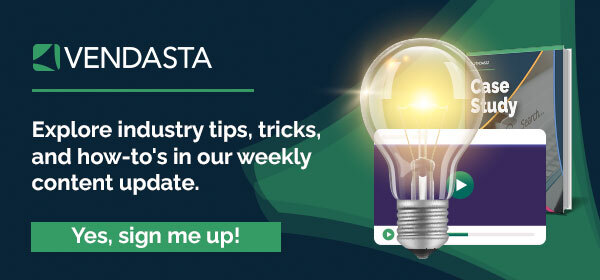How to scale revenue by selling high-margin product and service bundles
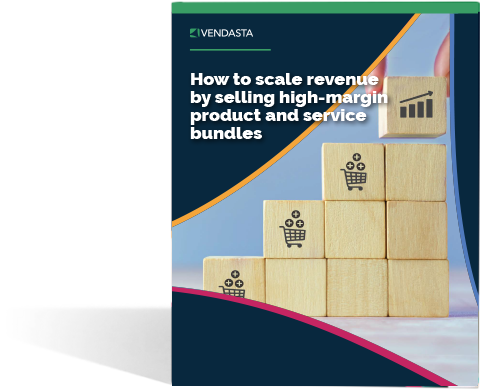
Keep reading to discover:
- Actionable product bundling strategies you can start using now to boost your revenue
- The packaging pitfalls you need to avoid to prevent overwhelm and confusion with your agency clients
- The secrets to bundling for each stage of the customer journey
- Exactly what you need to know before pricing your packages appropriately for prospective and existing agency clients
- How bundling can be your answer to client churn
- Step-by-step instructions (with a customizable deck) for pitching those packages to your agency prospects
Introduction
In this guide, we examine the basic principles of digital marketing service packagese and the benefits for your agency. You’ll discover the difference between service marketing vs product marketing bundles, see marketing packages examples, and learn about marketing packages pricing. In addition, you’ll learn how to craft a perfectly curated marketing bundle of digital solutions from Vendasta’s Marketplace.
Not only can high-margin marketing service packages be the key to unlocking success and profitability for your agency, but it will offer your local business clients the tools and services they need to achieve a successful online presence.
Bundle digital solutions
and grow your revenue
What is product and service bundling?
Marketing bundles: Your agency’s key to profitability
For example, if your boutique fashion store client is keeping up with their posting and engagement on their social media accounts, they may encourage potential customers to conduct a Google search about their business. Once the customer lands on that business’s Google Business Profile, they’ll scroll through some of the reviews for the business to see what other customers are saying about their interactions with the boutique. If the reviews are positive, the new customer may be encouraged to visit the SMB’s recently redesigned website, where they can complete an online purchase or decide to visit the store in person.
In an increasingly challenging and competitive market, agencies can quickly position themselves as a front runner just by crafting the perfect marketing bundle that spans this entire customer journey.
Why?
The agency that is only selling one marketing service is leaving holes in the customer journey for prospects to fall out.
Take ads for example: If an agency is only selling digital advertising, there is a good chance that the local business’s advertising dollars will be funding their competitor. The ads might drive a prospect online to do research, but during research, that person might realize the competitor has better reviews, a better website, or higher rankings in search results. As a result, they will be more likely to convert with the competitor.
Marketing agency service packages allow you to sell more services that cover the entire customer journey, which enables local businesses to generate more revenue.
![Your million-dollar pitch deck for selling digital [MAKE A COPY] Your million-dollar pitch deck for selling digital [MAKE A COPY]](https://www.vendasta.com/content-library/wp-content/uploads/sites/2/Your-million-dollar-pitch-deck-for-selling-digital-MAKE-A-COPY.jpg)
A winning marketing bundle should offer immense value to the client while maintaining a strong profit margin for the agency.
At Vendasta, we recommend three primary delivery methods when selling digital solutions and services to SMBs:
Do It Yourself tm
Do It Yourself (DIY) is the most cost-friendly option for businesses. It works best for local business owners with smaller budgets who are willing to invest some time into interacting with their own customers online through tools that will cut down on the toil.
Do It For Me tm
Do It For Me (DIFM) is more costly for local businesses; however, it completely removes their need to manage accounts and interactions themselves, making the additional spend worth it for many time-starved local business owners.
The DIFM service model will require some additional time and fulfillment from your agency team, and pricing should be set according to cover your delivery costs, leaving room for profit as well.
Do It With Me tm
Do It With Me (DIWM) is a hybrid of the other two options, and can be an effective way to deliver services to your clients with middle-of-the road budgets in mind.
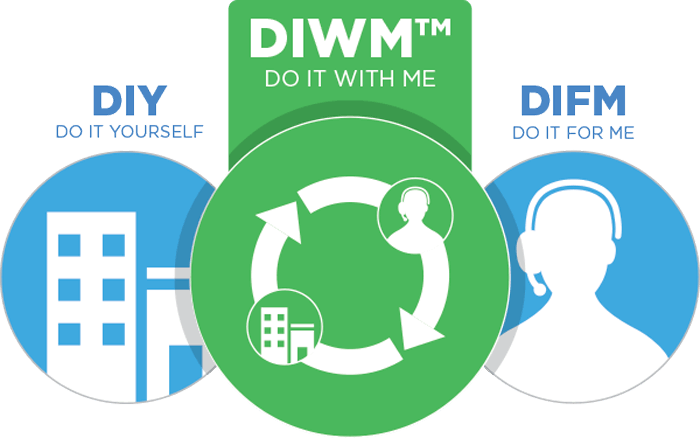
Later on in this guide, we will dive deeper into the exact formula for producing a high-margin DIY marketing bundle with a rinse-and-repeat sales cycle that can help skyrocket your agency’s growth. We’ll share the recommended cost breakdown for our most popular digital solutions so you can learn how to make money selling bundles and demonstrate how to prove value and retain clients with automated proof-of-performance reporting.
Before we get too deep, however, let’s explore some of the do’s and don’ts every agency should consider when packaging products and services to best fit the client’s needs.
Subscribe to our newsletter
Explore industry tips, tricks, and how-to’s in our weekly content update.
How to sell product bundles
When you’re trying to determine how to sell bundles, there are two main types of marketing bundles you should know about: Mixed bundling and pure bundling:
- Mixed bundling includes the marketing bundle and also the individual products and services that are a part of the bundle. This means that the products and services included in the marketing package are available to be sold individually if that is a better option for the customer.
- Pure bundling includes only the products offered in the marketing package, meaning these products are only available when purchased as a marketing bundle and cannot be purchased separately. This option is very restrictive in comparison to mixed bundling. This is limiting to customers and is a far less common bundling tactic than mixed bundling.
Exceptional customer service is an integral part of product and service bundling for marketing agencies. Customers can undoubtedly search for and find similar products to your offerings elsewhere. But if you have high customer satisfaction and great online reviews, you will stand out as the number-one choice. Don’t forget to sweeten the marketing bundle deal with an emphasis on the savings clients can expect from purchasing a digital marketing services package.
Bundling can introduce clients to products that they didn’t know they needed; however, this only works if the reseller is bundling strategically.
Strategy 1: Bundle for each stage of the customer journey
Reselling marketing bundles can look similar to selling individual products. Customer research, freemium products, bundling tactics, up-selling and cross-selling opportunities, digital marketing monthly service tier packages, and referrals are all a part of bundling throughout the customer journey.
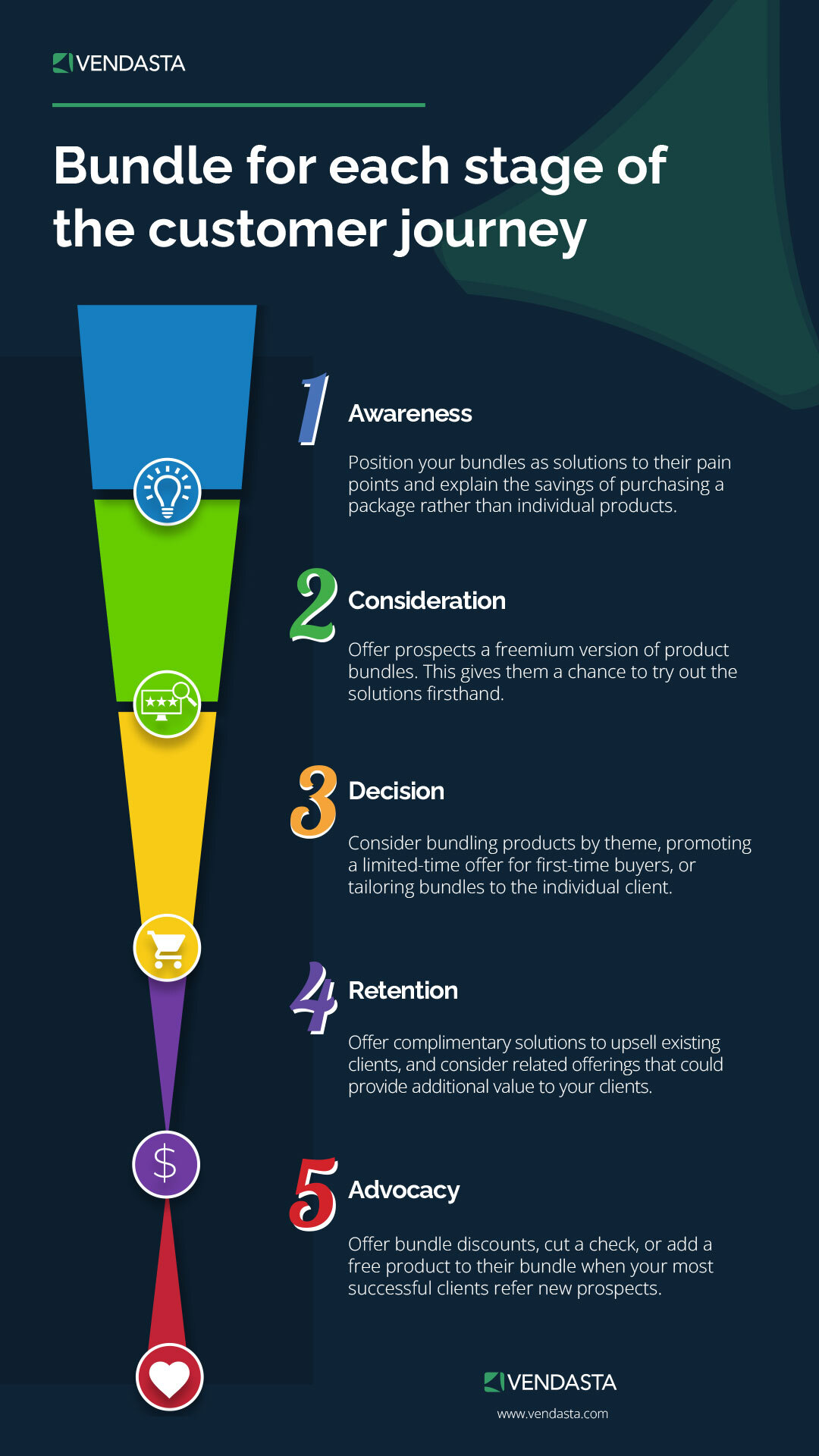
Phase 1. Awareness
As you make prospective clients aware of your offerings, it’s important to position your marketing bundles as solutions to their pain points. Customer research is important at this stage. It’s also important to showcase the benefits of bundling and explain how much your clients can save by purchasing a digital marketing service package rather than individual products.
Phase 2. Consideration
At this stage, you can offer prospects a freemium version of all product bundles. This gives them a chance to try out the solutions first hand. If they are satisfied, it can successfully lead to them purchasing the full version of the best product bundle fit.
Phase 3. Decision
Bundling tactics at this stage may include bundling marketing products by theme, putting a limited time on exclusive bundle deals for first-time buyers, or tailoring marketing bundles to the individual client.
- Themes solve for a clear problem such as difficulty managing an online reputation.
- Time limits create a sense of urgency.
- Specific deals for first-time buyers give them a feeling of uniqueness.
- Tailored bundles make clients feel well taken care of in the sense that the reseller understands their specific needs.
Phase 4. Retention
The retention phase is your opportunity to upsell and cross-sell.
Product bundles examples:
Add-ons like Vendasta’s Listing Sync Pro and Listing Distribution are great upsell options for clients who are already using Listing Builder.
For that same client, a good product to cross-sell might be Reputation Management. Because they are trying to build up their online presence with Listing Builder, they’ll probably need to find a way to better manage that online reputation.
Phase 5. Advocacy
At this stage, resellers should approach their most successful clients with a referral deal.
This can look like further bundle discounts, cutting a check, or adding a product to their bundle for free once they’ve referred a certain number of prospects.
Referral marketing is an authentic tactic that holds less bias than an agency promoting themselves.
Each phase that a client moves through requires a different approach and gives you the opportunity to sell more. Know your customer. The key to creating marketing packages throughout the customer journey is to research and understand each individual client’s needs. Always have a one-to-one conversation with each client after conducting research to better understand their pain points and discuss bundled solutions.
Strategy 2: Mix low-selling and fast-moving items
Combine products and services that complement each other and aren’t usually sold individually.
A strategic mix of less popular and more popular products bundled together is a great option for introducing those low-selling products to clients.
Here’s a product bundles example that mixes low- and fast-moving items: Perhaps you have a great product to resell but it’s newer, lesser known, or just hasn’t been positioned well. This strategy provides a great opportunity to shine a light on it and make those lesser-known products visible. Introducing new products through a bundle is a savvy strategy to include in the marketing mix.
A low-selling product or service isn’t necessarily something to overlook. It can still be a valuable product for clients if sold in a smart mix. Perhaps an add-on to social media management isn’t popular initially or on its own. If you sell it in a bundle with that social media management product or service, your customers are more likely to see the value in it.
Strategy 3: Piecing together the digital solution puzzle
According to Vendasta Partner Development Manager Arpit Madan, all agencies need to be familiar with what he calls a digital puzzle. This puzzle is a seven-step checklist of solutions that build off of one another. Each solution is a piece of that puzzle and not all solutions fit together perfectly.
Some pieces like website solutions and on-site SEO fit together, but digital advertising campaigns don’t fit into the first two pieces, and so there has to be another piece connecting them.
Here are some marketing packages examples from Vendasta:
Products and product categories build on one another intuitively with suggestions throughout Vendasta’s product pages and recommended packages.
At the beginning of their journey, clients may need help managing their online reputation and building an SEO strategy from scratch. Further along, that same business might be in a good position to start spending on digital ads, but that’s not something worth spending money on until they’ve built up their online presence. As you become familiar with the more than 250 digital solutions in Marketplace, you’ll be able to bundle and resell solutions in whatever groupings work for you and your clients.
Build bundles based on the solutions categories in the below order so that customers get the most value out of the products you resell, at the right time.
The digital product puzzle:
- Optimized website: Tools include Website Pro, GoDaddy, and Domains.
- On-site SEO: Tools in Marketplace include Alpha SEO and Boostability SEO.
- Local SEO: Yext Listing Sync Pro and Listing Distribution are both Marketplace tools that help develop authority with search engines.
- Reputation management: The Reputation Management product provides a singular dashboard to manage all reviews.
- Tracking tool: Executive Report found in Vendasta’s Business App is an automated assessment that gives resellers access to proof-of-performance reporting and data-informed product and service recommendations.
- Social: Marketplace tools include Social Marketing, Social Media Management, GetSocial, and Metricool.
- Ad campaigns: Marketplace products and services include AdCellerant, Digital Advertising Services, and many more options.
- Bundling web design and SEO
- Packaging SEO and PPC management
- Bundling different types of white-label content into marketing service packages
- Create social media packages with a variety of different products and services
- Create SEO packages and learn how to price those SEO bundles effectively
Strategy 4: Marketing packages pricing
Part of knowing your client is understanding their value perception of your products. This will influence which products are selected for marketing bundles and how you set marketing packages pricing. Perceived value is a customer’s individual perception of a product or service’s value to them, and it’s measured by the price they are willing to pay for that marketing bundle.
Digital marketing service tiers packages
Digital marketing service tiers packages show businesses how they can grow with the available products and services. Generally ranging from a freemium or entry-level bundle all the way up to an enterprise, cream-of-the-crop marketing service package, this structure clearly lays out a growth pattern.
For a business that is beyond the basic package, but not ready to pay out what the top-tiered bundle costs, there should be a small variety of digital marketing packages. Or, if you cater to a very specific audience, add a carefully selected product bundle in the middle. Why? Psychologically speaking, most businesses will choose the middle tier when you price digital marketing service tier packages.
When it comes to how to sell bundles, tiered bundles simplify the marketing packages pricing system by showing a range of choices priced accordingly. They also enable upselling to the next bundle when a business outgrows its current bundle. This makes sales less complicated as long as the client is satisfied with the base products.
Buy more pay less
A classic positioning statement that will help you discover how to make money selling bundles is “buy more, pay less.” Essentially, all marketing bundles should be following this marketing packages pricing strategy, because this is really the whole point in buying a bundle of products and services.
Rather than paying the full price for a number of products individually, a small business can get those same products plus a little extra for a discounted price if they’re willing to purchase them all together.
Of course, if clients require a product that is not included in that bundle, they will then pay for that product as an add-on. This means resellers will sell more products and their clients will have their digital needs taken care of. Rather than taking care of one thing at a time with one product at a time, small businesses will have a well-rounded digital marketing strategy.
Profit margins
We all enjoy the feeling of empowerment when it comes to being given a choice but more often than not in a set of slightly differing options, we will choose the one priced in between the lowest and highest prices. A psychological theory called middle option bias highlights our natural tendency to select the middle option, or in this case, the middle-of-the-road product bundle. This is foundational to digital marketing monthly service tiers packages. This theory gives agencies some wiggle room to price the middle product bundle higher than they might think at first.
It’s your job to know your client, the market, and your products. With that knowledge, it will be easier to decipher your client’s perceived value of your bundles. As much as a client doesn’t want to overpay for a marketing bundle, you don’t want to undercharge.
Typically, Vendasta partners selling our foundational marketing agency service packages have a markup of 40 to 60 percent above the wholesale price.
Learn how to sell bundles of services more effectively
Price is the most tangible aspect of a service at the point of decision. By bundling services, you can present prospects with a below-market price for the individual services included in a marketing bundle. The following five digital marketing packages examples illustrate different techniques for selling bundled services.
1. Provide tangible toolkits
In order to turn your service into a product, you can provide tangible evidence of your expertise in the form of templates, checklists, whitepapers, and guides. Combine these elements into themed toolkits for sales enablement, such as:
- developing a social media strategy
- how to manage an online reputation
- an SEO management handbook
- building a digital marketing plan
These toolkits can be added to similarly themed bundles of products and services.
2. Use sales intelligence tools
Resellers can take advantage of sales intelligence tools like Vendasta’s Snapshot Report to determine what service or product a prospect needs. This report evaluates a prospect’s online presence. It might indicate that they’re failing at SEO or digital ads, for example. It shows resellers where the prospect’s pain points lie, allowing them to determine which of their services or products will fill each client’s needs.
3. Combine products and services
The Vendasta Marketplace includes over 250 products and services to resell. This presents a unique opportunity to build on your core offering with bundles that include both products and services. A combination of both can best serve your clients and prove your value as the agency of choice in your field.
4. Package different service levels
When you know your client and their needs, you will be able to package together different services based on the concept of tiered bundles. Much like a reseller can have three tiers of product bundles ranging from basic to enterprise level with pricing that reflects the value of the package, you can do the same with services. Piece together relevant services, such as SEO and copywriting, depending on the level of effort required on your part, and then price those bundles accordingly.
5. Bundle the process of how you deliver
If you are still having difficulty deciphering how to package your services, think about packaging your delivery process instead. Similar to a tangible toolkit that provides sales enablement, this will look like a tangible document that takes prospects through your service delivery process.
For example, if you offer reputation management services, this could include review responses. The process for review responses would include tailoring the tone and wording, explaining how you take the conversation offline in response to negative reviews, and how you manage reviews from a number of platforms and listing sites all in one place to ensure nothing is missed.
The delivery process should be written out logically to outline exactly how you will take care of your prospect and prove why you are the right agency for the job.
Product and service bundling mistakes to avoid
Even though marketing agency service packages are theoretically easier to sell than individual products and services, their positioning, and how they are put together, is very important to their success.
Mistake 1: Selling too many package options
Although you might have access to an extraordinary number of pieces to the digital puzzle, it would be smart to avoid too much of a good thing. Too many bundles and options within those bundles can quickly overwhelm prospective clients, leading them to drop out before completing a sale. This is not a good way to sell bundles.
The paradox of choice tells us that having too many choices leaves people overwhelmed, dissatisfied, and sometimes anxious. Barry Schwartz, author of The Paradox of Choice: Why More Is Less, studied the intersection of economics and psychology. One of his observations was that, although our number of choices have increased dramatically over the past century, consumer satisfaction has not increased at the same rate. In fact, having an overwhelming number of choices was actually making people less happy with the decisions they made. Dissatisfaction and second-guessing of decisions actually increase when more options are available because people don’t know if they’ve made the best possible decision.
It’s important to restrict the number of marketing bundles available to between three and five.
Mistake 2: Undefined package scope
Don’t leave clients wondering because this leads to confusion, frustration, and, ultimately, churn. This mistake can be avoided by defining the scope of your marketing bundles and asking yourself:
- How long should a client expect to wait before seeing specific results?
- When does the bundle get renewed?
- Exactly how much should you charge for marketing services bundles, and will there be any necessary add-ons in the near future that will cost more?
By defining the scope of your marketing bundles and each of the products included, you give yourself the power to set the client’s expectations realistically. Although there aren’t necessarily any guarantees, this sets clients at ease because the expert they paid has a clearly defined job to do.
Depending on the products and services offered in a bundle, you should define the length of time necessary before a client can expect to need an add-on or upgraded package. This basically guarantees upselling opportunities and keeps customers’ results from plateauing.
Mistake 3: Selling intangible results
You have to give prospects a reason to buy from you rather than a competitor. Review the section Learn how to sell bundles of services more effectively for more in-depth information on selling intangible results or stay here for the bullet points:
- Provide tangible toolkits | For example: templates, checklists, white papers, guides etc.
- Use sales intelligence tools | Vendasta’s Snapshot Report can be used to evaluate a prospect’s online presence
- Combine products and services | Sell mixed bundles of products and services together
- Bundle different service levels | More in-depth services can be priced higher than a bundle of basic services
- Bundle the process of how you deliver | Create a tangible document that walks prospects through your service delivery process
You should be able to show prospects what kind of results they can expect from each of the offered bundles using the above tactics. It’s also important to use data to back up the expected impact of your products and services.
Above all else, speak in the language that your clients understand. It’s hard enough to sell something intangible, so why make it more difficult by expecting them to know exactly what they need? Business owners are coming to you for help with a specific digital need because they are not experts in your field. Speaking in plain language and explaining basic terms and functions of your digital offerings can go a long way in establishing the foundation of a relationship.
Pitch your bundle: How to sell bundles by positioning yourself in a competitive market with storytelling
Unlock the power of a digital solutions bundle that could translate into an additional $1 million in annual recurring revenue for your agency.
The ultimate pitch for selling digital
There’s a ton of noise out there, but one of the easiest ways to cut through the competition is by telling a powerful story when selling bundles. Having the best products and services isn’t enough. If you don’t have a story that compels your prospects—that gets to the heart of their needs—you won’t win in a crowded marketplace.
According to cognitive psychologist Jerome Bruner, stories are 22 times more memorable than facts and figures alone. In fact, our neural activity increases five times when listening to a story.
At Vendasta, we’ve developed a digital sales pitch deck based on proven methodology developed by Tim Riesterer from Corporate Visions. The framework is based on the principle that clients don’t need to be told why to do something, they need to be told why they need to change and why they need to do it now.
Unlock the key to profitability
Setting expectations
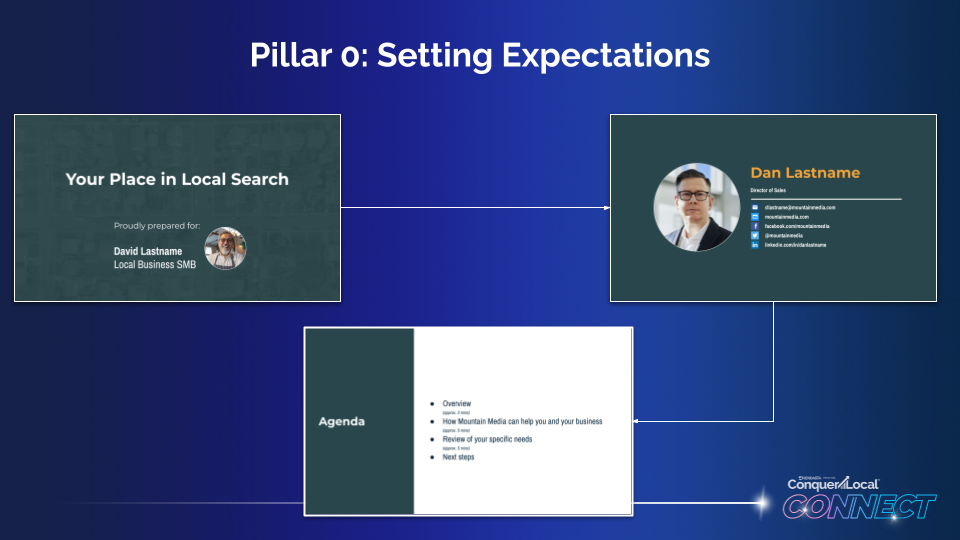
Pillar 1: Introduce an unconsidered need
After introductions and stage setting, the first thing you should be doing in your digital bundle sales presentation is to introduce your point of view to the prospect. It doesn’t need to be revolutionary, but it does need to be true because this viewpoint will lay the groundwork for the rest of the presentation. You are preparing your customers to be destabilized and are taking the time to set yourself up as a trustworthy solution to their unconsidered need.
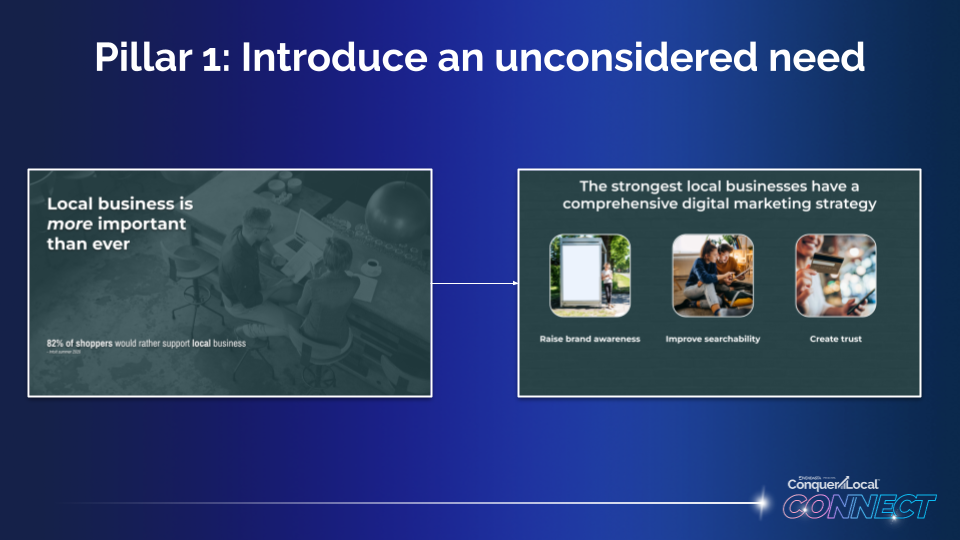
That should be the unconsidered need.
Pillar 2: Loss aversion theory
Next, you should move into this framework’s second pillar: loss aversion theory. Loss aversion theory tells us that the pain of losing $10 is greater than the pleasure of gaining $10, so we’re showing them how painful it would be to not take action on the unconsidered need we introduced.
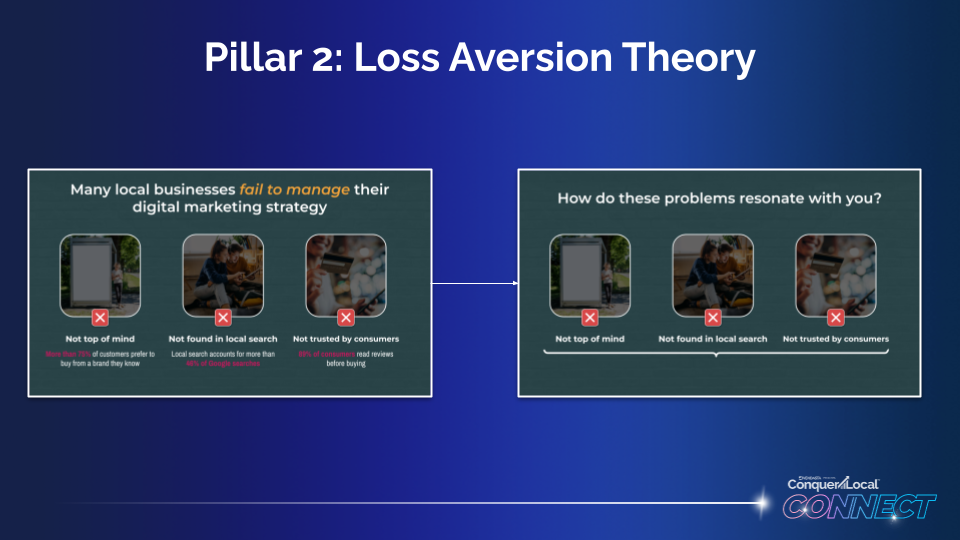
You should be spending time building up trust with your customers by sharing your industry knowledge and expertise. Demonstrate why you are the right person to help solve the problem before you demonstrate the solution.
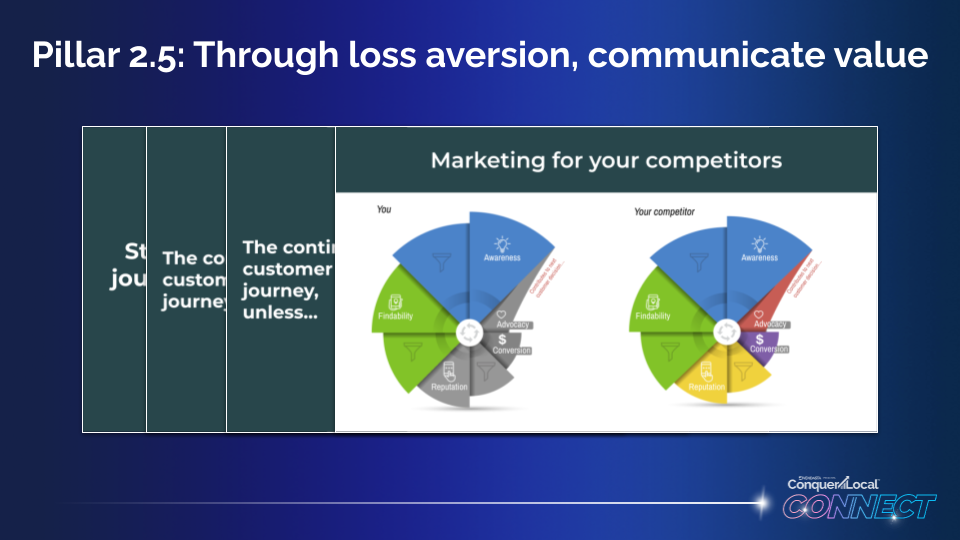
Pillar 3: Communicate value by contrasting present and future
Now that you’ve created enough pain and built up enough trust, you can move on to the third pillar—communicating value by contrasting your prospect’s present state with a future state where they follow your expert advice. Show them your solution bundle, some examples of what winning might look like, and then ask: “Would a future state where your unconsidered need is solved be better than now?” A prospect should fairly obviously know that the answer is yes.
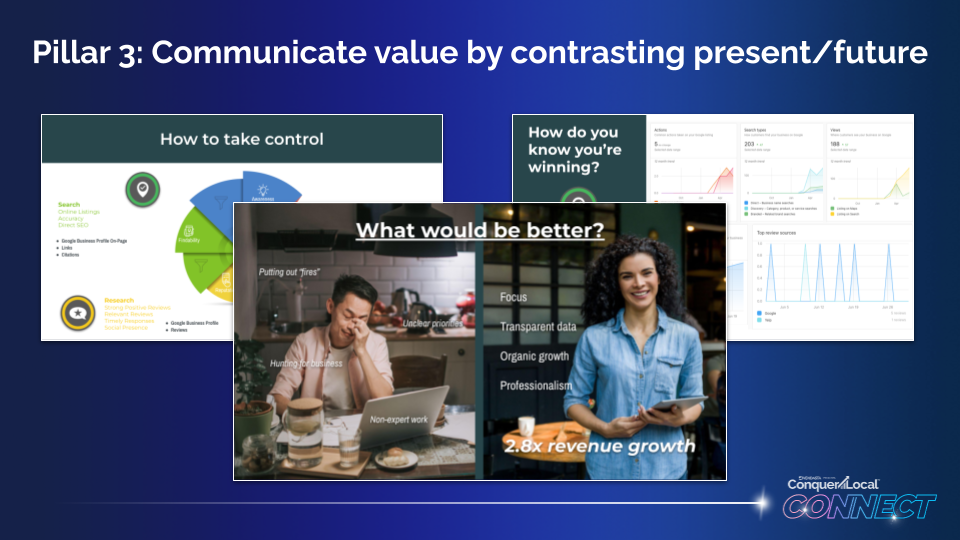
Pillar 4: Introduce your hero story
Finally, before your prospect can start anticipating any regret, move into the fourth pillar and show them a hero story they can imagine themselves in. Mix in numbers, graphs, and visuals here. Doing so is extremely effective when telling a story. Choose a successful example of your work for best results.
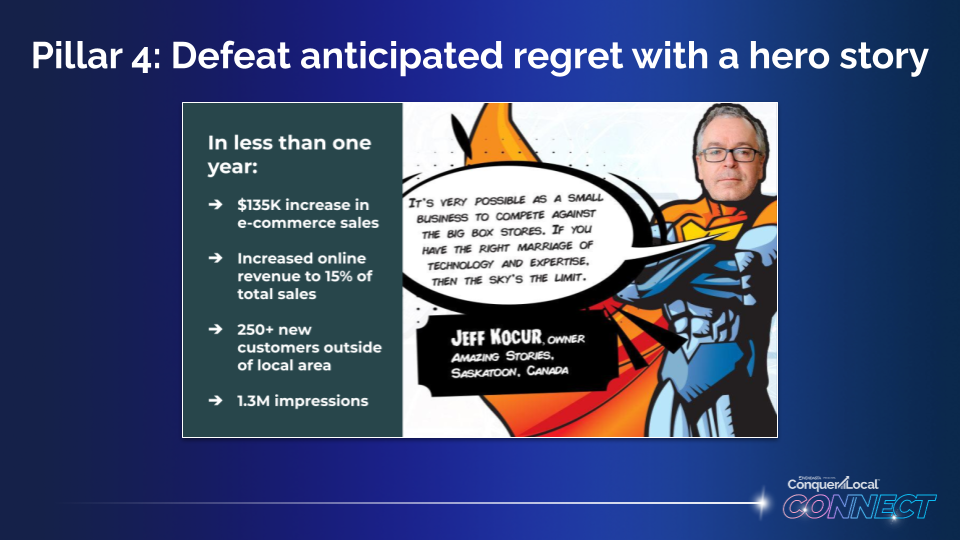
Get started by selling Vendasta’s Customer Journey Pro high-value digital marketing product bundle
With Vendasta’s Customer Journey Pro bundle, we’ll be highlighting three of the most popular foundational solutions for the online success of local businesses:
Reputation Management
Vendasta’s Reputation Management app lets your clients manage their reviews from hundreds of sites and respond in just a couple of clicks with pre-written, smart templates powered by artificial intelligence (AI).
They can benchmark their reputation against competitors, analyze sentiment, and use insights to manage their business more effectively.
Listing Builder
Vendasta’s Listing Builder app is one place for your clients to keep information about their business—such as name, address, hours of operation, and phone number—consistent across sites like Google, Facebook, Instagram, and Twitter. So when some of their business details change, those changes are reflected everywhere online.
Social Marketing
Vendasta’s Social Marketing app helps you and your client gain control of their social media presence. You can create calendars of social posts in advance, post to Facebook, Instagram, Twitter, and Google simultaneously, and find new potential customers in their area.
Bundling together Reputation Management, Listing Builder, and Social Marketing through the Vendasta platform will give your local business clients access to:
- A centralized login to access these three apps, so they can manage their online presence, reviews, and social media in one spot.
- Automatic reporting that brings together your clients’ online performance and continues to show value over time.
In addition, it is recommended that your team delivers on the elements described below to complement the roll out of this digital solution bundle:
- Have your team use Vendasta to claim your clients’ most essential business listings on Google, Facebook, Instagram, and Twitter, and ensure your clients’ business name, address, phone number, hours of operation, and website details are synced, consistent, and accurate.
- Your team will also respond to any reviews that come through for your clients on essential review sites.
- And finally, your team will create two (2) engaging social posts for your clients each week on their Instagram, Facebook, Twitter, and Google Business Profile.
- You’ll also schedule a check in with your clients in 30, 60, and 90 days, so you can review all of the great work your team has been doing to help your client.
It’s this product bundle example combination of effective marketing tools and ongoing services from your agency team that make the Do It With Me tm approach incredibly valuable for your clients.
Break down your formula for B2B profitability
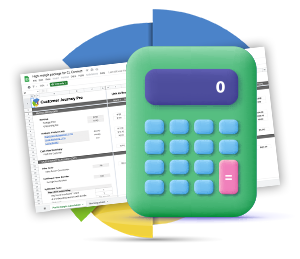
Generate more monthly recurring revenue by selling bundles
Now more than ever, it’s critical for agencies to operate as efficiently and profitably as possible. High-margin digital product bundles allow you to do just that. By simplifying your solution set, bundling using key strategies, and executing in a scalable way, you can not only ensure the growth of your business, but happier and healthier client relationships over the long term as well.
Bundle Vendasta’s web design and SEO services for agencies
Customer Journey Pro profitability calculator
How to bundle white-label content into packages with Vendasta
How to create, promote, and fulfill SEO packages
How to offer social media marketing packages at scale
How to price monthly SEO packages: 9 questions to consider
Product bundling examples that convert
Product bundling is a smart strategy — But there’s a catch


